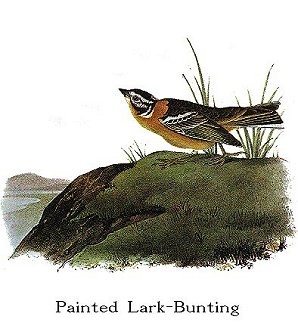
| Family XV. FRINGILLINAE. FINCHES. GENUS I. PLECTROPHANES, Meyer. LARK-BUNTING. |
Next >> |

Family |
PAINTED LARK-BUNTING. [Smith's Longspur.] |
| Genus | PLECTROPHANES FICTUS, Swains. [Calcarius pictus.] |
This handsome species was discovered by Dr. RICHARDSON in April 1827, on
the banks of the Saskatchewan river, associated with the Lapland Longspur. Only
one specimen was procured at Carlton House, which has been figured by Mr.
SWAINSON in the Fauna Boreali-Americana. My own figure of this species was
drawn from the same specimen, which was kindly lent to me for that purpose by
the Council of the Zoological Society. That the Painted Bunting at times
retires far southward, probably accompanying the Lapland Longspur, is a fact for
which I can vouch, having seen one on the shores of the Mississippi in December
1820, which however I missed on wing after having viewed it about two minutes,
as it lay flat on the ground.
EMBERIZA (PLECTROPHANES) PICTA, Painted Bunting, Swains. & Rich. F. Bor. Amer. vol. ii. p. 250.
PAINTED BUNTING, Nutt. Man., vol. ii. P. 589.
PAINTED BUNTING, Emberiza picta, Aud. Orn. Biog., vol. v. p. 91.
Adult Male.
Bill short, conical, stout, compressed toward the end, acuminate; its
outlines straight, the lower mandible a little narrower than the upper at the
base; the gap-line straight, slightly deflected at the base. Nostrils basal,
rounded, partly concealed by the feathers.
Head of moderate size, ovate; neck short, body compact. Feet of ordinary
length; tarsus compressed, anteriorly covered with seven large scutella, sharp
behind; toes of moderate size; the lateral toes equal, the hind toe stout; claws
long, slightly arched, laterally grooved, compressed, very acute, that of the
hind toe much elongated.
Plumage soft and blended, the feathers somewhat distinct on the back and
wings. Wing long, pointed, the second quill longest, the first nearly equal;
the second, third, and fourth primaries attenuated on the outer web toward the
end. Tall rather long deeply emarginate.
Bill dusky, lower mandible yellow toward the base. Feet and claws
reddish-brown. The upper part and sides of the head are deep black, with three
bands of white on each side, one extending from the base of the upper mandible,
over the eye, and along the side of the neck; another passing under the eye and
over the ear; the third bordering the throat. There is also a brownish-white
patch on the nape. A band across the hind neck and fore part of the back and
all the lower parts buffy-orange. The feathers on the upper parts of the body
blackish-brown, edged with light brown; the quills and their coverts
brownish-black, edged with pale brownish-red; the first row of large coverts
black, margined with white, the next two rows white, the rest of the small
coverts brownish-black. The tail-feathers are brownish-black, margined with
pale greyish-brown, excepting the two outer on each side, which are white,
margined externally towards the tips and along the inner webs with brown.
Length to end of tail 6 2/12 inches; bill along the ridge (5 1/4)/12; wing
from flexure 3 1/4; tail 2 1/4; tarsus (10 1/2)/12; hind toe (3 1/4)/12; its
claw 6/12; middle toe 7/12, its claw 3/12.
| Next >> |